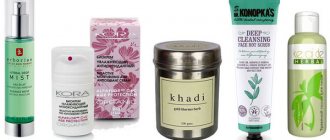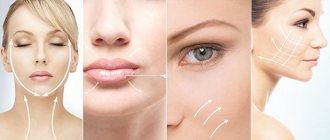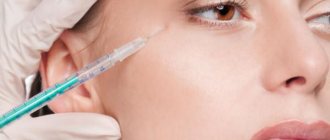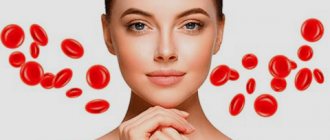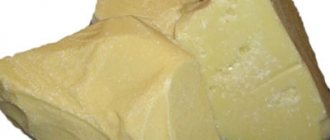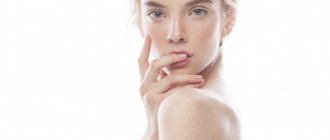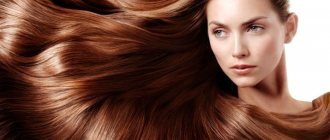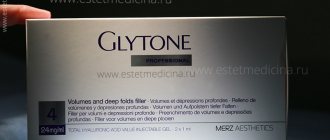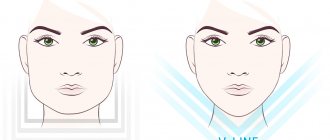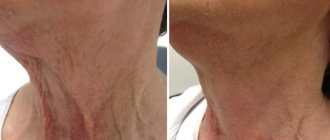Why does a nasolacrimal trough form?
A cosmetic defect can occur in middle-aged and elderly women, but it also occurs in girls under 30 years old, which is due to the characteristics of the skin and other factors.
The furrow is a slight depression formed in the area of the inner corner of the eye, and continues in the direction of the arc that forms the cheekbones. It is also called a deep wrinkle or fold.
There are several reasons that can provoke the problem:
- A sharp change in body weight in one direction or another. In this case, the skin sags or stretches, which certainly leads to a loss of elasticity.
- Bad habits. Women who abuse alcoholic beverages and tobacco products are more likely to notice the appearance of folds.
- Excessive physical activity and fatigue.
- Professional activities associated with contact with toxic substances. Typically, such work has a negative impact on the skin.
- Age-related changes in the skin associated with a decrease in the production of collagen and other components that maintain the elasticity of the skin.
- Skull injuries.
- Disorders of the heart and kidneys, causing stagnation of blood and fluid.
- Severe brain pathologies.
- Regular insomnia associated with psychoemotional disorders.
- Diseases of the endocrine system, for example, thyrotoxicosis, hypothyroidism or diabetes.
One of the common reasons is considered to be improper care of the skin of the face. An unsuitable cream, scrub or lotion can cause tissue swelling and other problems that ultimately lead to the appearance of creases.
How to prevent tear trough formation?
Everyone knows that any problem is always easier to prevent than to treat. Therefore, prevention of tear trough formation should be started immediately. And if there is a hereditary predisposition, then this can be revealed by looking at your relatives - then you will have to work even more actively. Even if a problem has arisen, a list of innovations in your usual way of life will help correct the situation:
- proper nutrition - you need to eat more vegetables and fruits, less sugar, salt and smoked foods;
- regular physical activity (you don’t need to buy a gym membership at all, just a 30-minute leisurely walk is enough: this will have a positive effect on metabolic processes);
- correct drinking schedule (750 ml should be drunk before noon, the rest of the time the figure should be increased to 2 liters, but stop drinking an hour before bedtime);
- moisturizing your facial skin with creams that suit your age group;
- gymnastics for the face;
- treatment of chronic diseases.
We recommend: How is blepharoplasty with epicanthus performed?
The effectiveness of correction of the nasolacrimal groove with fillers and hyaluronic acid
Filling the nasolacrimal trough with fillers is considered the most accessible and simple procedure for those who are contraindicated for surgery or have other obstacles.
Fillers are made based on hyaluronic acid and other components. They are a gel-like mass that fills the voids under the skin and leads to the alignment of its relief. In this case, there is no need for an operation, the procedure takes a minimum of time, and its results are long-term.
It not only smoothes out the skin, but also stimulates metabolic processes and blood circulation, which improves color and eliminates redness. Many women feel discomfort when furrows form because the skin under the eyes becomes sensitive, thins and dries out quickly.
Filling the nasolacrimal groove with fillers is the most effective and safest option for correcting this area of the face. Photos before and after the procedure.
After the procedure, all these problems disappear, which also proves its effectiveness and safety if carried out correctly.
Why is she becoming so visible?
The main reason for the bluish color of the furrow is that the vessels and orbicularis oculi muscle are visible through the skin. Triggers for the formation of this deficiency are age-related or genetic “weight loss” of adipose tissue under the eyes. Because of this, the relief of this area changes, unnecessary shadows are formed, which visually gives the eyes a tired look.
Most often, a pronounced furrow becomes noticeable after 35-40 years.
Contraindications for correction
Despite the relative safety and effectiveness of the manipulation, it is not always permitted.
Some contraindications must be taken into account:
- Intolerance to drugs used in furrow correction.
- Any malignant neoplasms in the body.
- Eczema and psoriasis in the acute stage.
- Chronic dermatitis, urticaria with regular relapses.
- Damage to the skin in the furrow area.
- Purulent lesions on the skin in the eye or nasal passages.
In each case, the specialist individually makes a decision on the advisability of the procedure.
Comparison of the technique with other correction methods
Correction with fillers has its advantages and disadvantages. A woman should familiarize herself with all the manipulations that can eliminate the furrow in order to understand which one is right for her.
| Name of procedures | Peculiarities | Effect duration |
| Surgical intervention | There are 2 main procedures that require surgery - lipolifting and cutting off adipose tissue. The first procedure involves taking adipose tissue from different parts of the patient’s body and then filling the nasolacrimal fold with it. It is performed under local anesthesia. The second involves cutting off fatty tissue in the area of the furrow, if it is quite deep and combined with bags under the eyes. The manipulation is performed under general anesthesia. | The effect of lipolifting lasts for 3 years; after excision, the specialist gives a guarantee for 10 years. |
| Hardware techniques | Today, lifting with ultrasound and radio waves is considered the most popular. Both manipulations are carried out in courses, the number of procedures depends on the severity of the furrow. The patient does not require pain relief. Thanks to the healing effect, metabolism in the fold area is stimulated, and its own collagen is formed, which fills the space. As a result, the fold is smoothed out. | The effect of such manipulations lasts no more than 3-4 months. |
| Injection method of correction | Fillers based on hyaluronic acid and other components fill the voids in the area of the nasolacrimal groove, which leads to its smoothing. | After manipulation, the result lasts for 6-8 months. |
The disadvantage of correction with fillers is the short-lived effect. However, taking into account the risks that the patient is exposed to during surgery, this manipulation is considered more gentle.
Precautionary measures
Contour plastic surgery of the nasolacrimal groove is not suitable for everyone.
Contraindications
Prohibitions on the introduction of filler are:
- inflammatory and infectious skin diseases;
- infectious processes in the body;
- pregnancy;
- diabetes;
- mental disorders;
- menstruation;
- blood diseases;
- the presence of benign or malignant formations;
- exacerbation of chronic diseases;
- intolerance to filler or anesthetic components;
- lactation.
There are also indirect contraindications. So, you need to resort to the procedure with caution if you have:
- “bags” under the eyes - swelling may increase;
- large pronounced hernias of the lower eyelids; in this case, migration of the gel, injection into the wrong areas, etc. may occur.
What could be the consequences?
The following are considered within normal limits:
- minor pain;
- hyperemia;
- bruises, hematomas;
- swelling.
Complications
They occur in the case of an incorrectly selected drug, due to the inexperience of the doctor, or when the rules of the rehabilitation period are violated.
In this case there may be:
- swelling that intensifies;
- formation of “rollers”, lumps;
- gel migration;
- the appearance of subcutaneous scars and nodules.
It is very rare that an allergic reaction to the drug occurs. In this case, an antihistamine is prescribed.
If the plastic surgery is unsuccessful, the filler can get into the vessel and then into the brain. This is a situation that requires urgent action as it can lead to blindness.
Any side effects are a reason to consult a doctor as soon as possible.
Types of drugs
Filling the nasolacrimal groove today is carried out using drugs from 3 groups. Each group has its own advantages and disadvantages.
Synthetic
Preparations from this group were created in the last century; they mainly contain paraffin and silicone. The main advantage of the funds is considered to be low cost. They provide a fairly long-lasting result and do not react with the patient’s skin cells.
However, synthetic fillers have a significant drawback. Once introduced into the voids, they are able to migrate to other areas, which can lead to the appearance of atypical defects on the face. An additional disadvantage of such drugs is the increased risk of developing an allergic reaction after administration.
Biosynthetic
Such products are considered 2nd generation drugs because they are based on synthetic ones, but are a more preferable option due to better compatibility with skin cells. Another advantage is the ability to persist in the human body for about 2-5 years.
Such products contain synthetic polylactic acid, as well as polycaprolactone and calcium hydroxyapatite. An important disadvantage of biosynthetic drugs is blockage of blood vessels and swelling of tissues. In this case, signs may appear immediately after administration or after some time.
Biodegradable
Popular fillers are made on the basis of a special substance, which, after injection, stimulates the natural processes of smoothing the skin. At the same time, the likelihood of adverse reactions is minimal, and the effect lasts from 8 to 10 months, which is almost the maximum period when using fillers.
Most often, the main substance is hyaluronic acid, which is normally produced in the human body and has unique properties. Another advantage of such drugs is the ability to be eliminated from the body naturally. Today, biodegradable fillers are considered the best and are used most often, as they guarantee results.
Preparation for the procedure
Preparing for the procedure does not take much time.
After selecting the appropriate drug, the following steps are performed:
- The specialist places the patient on the couch and puts a disposable cap on her head.
- Using special products, the skin is cleansed from impurities and excess fat.
- After this, the cosmetologist makes markings along the line of the furrow.
- An anesthetic is injected into the required areas, but more often a special cream with anesthetic components is used.
Before performing all the manipulations, the specialist tells the patient about the procedure, its duration and effectiveness. She should have an idea of all the actions of a cosmetologist.
Ways to neutralize the result
If a large amount of filler is injected or complications arise, urgent removal of the gel from the subcutaneous tissue is required. The best way is to inject hyaluronidase. As a rule, the effect is achieved the first time and works most effectively during the first two weeks after the procedure.
How to remove the drug after this period - with the help of massage, hardware therapy. The introduction of hyaluronidase at this stage is carried out repeatedly. Medicines that speed up metabolism also help. The name of the most common of them is Lymphomyosot.
How to make a correction
Filling is carried out after the anesthetic begins to act. The specialist begins the injection of filler or pure hyaluronic acid along the line of the nasolacrimal groove, marked at the preparatory stage. When using hyaluronic acid, the algorithm of actions is no different.
Using a disposable syringe with a miniature needle, a specialist injects a drop of gel at an equal distance, which allows the product to be evenly distributed. The punctures are shallow, usually the patient does not feel discomfort.
After treating the entire crease line, a gentle massage of the treatment area is carried out in order to distribute the gel and prevent its accumulation in one area under the skin. The entire manipulation lasts no more than 1 hour.
Many clinics offer women a soothing mask, which is applied after the filler is injected to cool the skin and prevent the development of inflammation.
Administration technique
At the very beginning, the cosmetologist sits the client in a semi-sitting position and opens the package with the drug in front of him. Be sure to demonstrate the sterility of the filler and its expiration date. After this, the nasal tear is prepared for the introduction of the gel.
Procedure steps:
- Cleansing. The face is wiped with a cleanser to remove dirt and makeup.
- Asepsis. The nasal tear is treated with an antiseptic.
- Anesthesia. Many doctors prefer to skip this point. The anesthetic drug can cause hyperemia or swelling, and since the procedure is quite quick, cosmetologists advise to endure several injections. But here everything depends on the patient’s perception. If he has a low pain threshold, he cannot do without a painkiller. In such cases, local topical anesthesia is performed - the application of Emla cream or other similar drugs. Next, wait until the drug begins to act - about 30 minutes. Doctors also use fillers with lidocaine, in which the first injection can be felt, and then the painkiller is distributed, and sensitivity disappears.
- The grooves are filled using a needle or cannula. The latter option is preferable, since there are many vessels and nerve plexuses in this area that are easily injured by a needle. The advantages of the cannula are that it has a non-sharp tip and does not damage the tissues, but simply moves them apart. The cannula is inserted in a retrograde-linear manner from below from the outer edge of the eyelid, moving towards the inner one. Next, under the skin, the cosmetologist moves it with his fingers in the desired direction and begins introducing filler. If the doctor prefers to work with a needle, then the microbolus technique is used. In both cases, it is necessary to take into account the patient’s skin condition and control the amount of the drug released. Correctly injected filler fills the depression in the sulcus and immediately evens out the skin, smoothing the transition from the lower eyelid to the cheek. The amount of injected gel is 0.2–0.4 ml on each side. It is not recommended to inject more than 0.5 ml into one groove. As for the patient’s sensations, during administration he may feel “bloating” or tingling. Even without anesthesia there should not be severe pain.
- Upon completion of this stage, an antiseptic is applied to the treated area.
- It is possible to apply a soothing and restorative mask or serum.
The entire session lasts 15–20 minutes. With anesthesia - half an hour longer.
Recovery time, features of the course
The duration of recovery after manipulation varies from woman to woman. Don't expect an immediate effect. It usually takes 10 to 14 days for the skin to completely recover and swelling and redness to disappear.
Throughout this entire period, it is recommended to follow a diet, namely, exclude salty, spicy and sour foods from the menu. It is important not to drink alcohol or take strong drugs, such as painkillers.
In addition, it is strictly forbidden to take a hot bath or sunbathe near a pond or in a solarium . You should not visit a bathhouse or sauna to avoid the possibility of increased swelling. If you follow the recommendations, the recovery period proceeds favorably.
Care after correction
If proper care is taken after correction, the likelihood of a furrow forming in the same place increases, so you should follow the cosmetologist’s recommendations.
Recommendations:
- The daily cream should be suitable for the patient’s skin type and age.
- When using decorative cosmetics, it is important to cleanse the skin with micellar water before going to bed.
- Creams with a cooling effect can be used for 2 weeks after correction.
- It is useful to use a cream for the area around the eyes containing hyaluronic acid. He will maintain the result.
You should not rub the area where the furrow was or massage or pull the skin so as not to provoke complications.
Possible complications and methods of their treatment
Filling the nasolacrimal trough with fillers often provokes complications. They can be minor or dangerous, so you should not ignore the symptoms.
Edema
Normally, tissue swelling disappears 3 days after the procedure. If this does not happen, you should visit a doctor who will determine the cause of the disorder and prescribe treatment. Usually a specialist prescribes an ointment that helps eliminate swelling. The most commonly used is Heparin ointment, which is applied 2 times a day in a thin layer for 3-6 days.
It is worth noting that the instructions do not suggest such use, but the experience of many patients proves its effectiveness. In most cases, additional therapy is not required.
Pain
Pain in the area where the gel was inserted may persist for several weeks after the procedure . The symptom is caused by skin damage or uneven distribution of the drug. Often pain is a reaction of the skin to the diameter of the needle.
If the pain is present only when touched, there is no need to worry, it will disappear after a while. If discomfort is constant, you should consult a doctor.
He will prescribe non-steroidal anti-inflammatory drugs, such as Indomethacin or Ibuprofen.
The drugs help eliminate pain, swelling and reduce the temperature in the affected area. This will ease the woman's condition. You need to take 1 tablet 2 times a day for no more than 5 days in a row.
Inflammation
The inflammatory process after correction in most cases is associated with the body’s reaction to a foreign substance. If swelling and redness does not disappear after 3 days, the symptoms worsen and other manifestations occur, you should consult a doctor.
Treatment usually involves taking antibiotics, such as Azithromycin.
The product helps to destroy microorganisms in the area of inflammation and is highly effective even when taking small doses.
The patient needs to take 1 tablet in the morning and evening for 3-5 days. If necessary, antipyretics are prescribed, for example, Paracetamol, as well as painkillers (Ketorol).
Necrosis
Necrosis is considered the most dangerous complication. It is the necrosis of tissue areas as a result of disruption of innervation and blood supply. In this case, swelling develops, redness and bruising appear.
After some time, the areas under the eyes turn black. This condition is treated by surgical excision of areas of dead tissue followed by antibiotic therapy. After surgery, the likelihood of facial expression disturbances increases.
Healing period
Immediately after the procedure, slight redness is observed, which disappears after about 15 minutes. If a vessel is injured, bruising may occur. All this goes away within a few days. The filler finally sets in after two weeks and by this time all side effects should go away.
To speed up the rehabilitation process, a cosmetologist may recommend:
- give up alcohol, air travel and sports for 3 days;
- do not touch your face with your hands until the puncture sites heal;
- for two weeks, avoid sudden changes in temperature, do not visit solariums, saunas, baths;
- do not apply makeup for 24 hours;
- treat the nasolacrimal area with an antiseptic for 2–3 days;
- stop using moisturizer while the filler is forming, so as not to provoke swelling;
- sleep on your back for the first 14 days;
- When bruises appear, lubricate these places with creams - Indovazin, Bruise-off, etc.
Is it possible to have a massage?
As a rule, massaging areas with injected fillers is not recommended. But if the gel is distributed unevenly, the doctor may prescribe kneading. A cosmetologist will tell you about the specifics of performing such a massage.
How long does the result last?
The nasal tear zone allows you to prolong the effect of the injected filler for a long time. The duration of the result depends on the chosen drug, the individual characteristics of the patient, compliance with the rules during the rehabilitation period and usual lifestyle.
According to reviews, repeated correction is needed no more than once every year and a half. And sometimes the filler retains its properties for several years.
Also, the duration of the result depends on how many times the patient has undergone contouring. If the gel is introduced for the first time, the body produces hyaluronidase, the antidote of hyaluronic acid, more intensively, and therefore the filler is removed faster.
Important point! With each subsequent injection, the metabolic process occurs more slowly and the result lasts longer.
The best drugs for filling the nasolacrimal trough
Filling the nasolacrimal groove is carried out using drugs with different compositions and properties.
There are tools that are used most often:
- Juvederm – the most popular products containing hyaluronic acid. This fills the furrow and stimulates the skin's natural smoothing processes. The drugs are effective, rarely provoke inflammation and necrosis, and many contain lidocaine to reduce pain. The main disadvantage of the funds is the increased risk of developing allergies.
- Teosyal redensity 2 are popular fillers, the composition of which includes hyaluronic acid supplemented with glycerol. The products are safe, retain their effect for at least 10 months and are well tolerated by patients. The only drawback is the high cost.
- Belotero soft – a fairly effective filler, which contains hyaluronic acid salts, but a minimal content of sodium hyaluronate. The product provides a long-lasting effect and rarely leads to complications. It also stimulates natural tissue repair processes and improves skin color. The drug has no disadvantages.
- Stylage S is a new generation French filler that provides long-lasting results and does not provoke allergic reactions. The composition contains high-quality hyaluronic acid, as well as other components that ensure effectiveness. In addition to lifting properties, the product has an antioxidant effect. The only drawback of the product is its high cost. However, the price is justified considering that the gel is packaged in disposable, convenient syringes, packaged in moisture-proof blisters.
There are many more drugs for correcting the nasolacrimal trench. Each of them has its own advantages and disadvantages. The choice is made by a specialist, taking into account the individual characteristics of each patient.
Cost of the procedure in Russian clinics
The price of correction of the nasolacrimal groove varies in different regions of Russia. In clinics in St. Petersburg and Moscow, the price ranges from 11,000-14,000 rubles. depending on the drug used.
In regions, for example, Voronezh, Kursk or Saratov, the price of such a correction can be 9,000-10,000 rubles. When using synthetic fillers, the cost of manipulation is slightly lower.
Filling voids in problem areas is considered a fairly popular procedure today. The nasolacrimal groove is most often corrected, since it is in this area that in most cases a cosmetic defect appears. To ensure that the procedure does not provoke complications, you should listen to the recommendations of the cosmetologist during the recovery period.
Preparatory stage
Before injecting filler into the nasolacrimal groove, you need to prepare for the procedure. The doctor must have a conversation with the patient, find out the specifics of his medical history and experience in using fillers. Next, he gives recommendations that must be followed for successful contouring.
Prohibited:
- dental procedures within two weeks before contouring;
- taking anti-inflammatory drugs, anticoagulants, aspirin, vitamins E and C 7 days before correction;
- playing sports and drinking alcohol the day before plastic surgery.
Note! In some cases, preparation may include other items. For example, for people prone to herpes, a doctor may recommend taking a preventive course of Acyclovir.
Before filling with fillers, the cosmetologist must tell the patient how the drug works and what areas it will be injected into. It is also important to warn about possible consequences. After which the patient gives a written agreement to undergo contouring.
